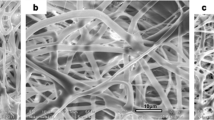Summary
In this study, a novel polyurethane membrane, modified by superfine silk-fibroin powder, was prepared for small-diameter vascular grafting. Scanning electron microscopy, transmission electron microscopy, and histological examination were applied to evaluate histocompatibility of this polyurethane membrane. The polyurethane membrane was compared with polytetrafluoroethylene material. A pseudomembrane and gap formed between polytetrafluoroethylene and the surrounding tissues, and no cells infiltrated or grew into the polytetrafluoroethylene material. On the contrary, superfine silk-fibroin powder/polyurethane blend membrane merged tightly with the surrounding tissues without gaps, and cells infiltrated and grew into the material. Moreover, the negative effects of superfine silk-fibroin powder/polyurethane blend membrane on cells were less than those of its polytetrafluoroethylene counterpart. Our findings indicated that the superfine silk-fibroin powder/polyurethane blend membrane has better histocompatibility than polytetrafluoroethylene membrane. It is concluded that the superfine silk-fibroin powder/polyurethane blend membrane is a promising biomaterial for small-diameter prosthesis.
Similar content being viewed by others
References
Yan YN, Wang XH, Yin DZ, et al. A new polyurethane/heparin vascular graft for small-caliber vein repair. J Bioact Compat Pol, 2007,22:323–341
Wang XW, Lin P, Yao QZ, et al. Development of small-diameter vascular grafts. World J Surg, 2007, 31:682–689
Khorasani MT, Shorgashti S. Fabrication of microporous polyurethane by spray phase inversion method as small diameter vascular grafts material. J Biomed Mater Res, 2006,77(2):253–260
Backdahl H, Helenius G, Bodin A, et al. Mechanical properties of bacterial cellulose and interactions with smooth muscle cells. Biomaterials, 2006,27(9):2141–2149
Marconi W, Galloppa A, Martinelli A, et al. New polyurethane compositions able to bond high amounts of both albumin and heparin Part 1. Biomaterials, 1995,16(6): 449–456
Kang IK, Kwon OH, Kim MK, et al. In vitro blood compatibility of functional group-grafted and heparin immobilized polyurethanes prepared by plasma glow discharge. Biomaterials, 1997,18(16):1099–1107
Man M, Baek DK, Cho JH, et al. In vitro blood compatibility of heparin-immobilized polyurethane containing ester groups in the side chain. J Mater Sci-Mater Med, 2004, 15(10):1079–1087
Lv Q, Cao CB, Zhu HS. A novel solvent system for blending of polyurethane and heparin. Biomaterials, 2003, 24(22):3915–3919
Altman GH, Diaz F, Jakuba C, et al. Silk-based biomaterials. Biomaterials, 2003,24(3):401–416
Zuo BQ, Dai L, Wu ZY. Analysis of structure and properties of biodegradable regenerated silk fibroin fibers. J Mater Sci, 2006,41:3357–3361
Roh DH, Kang SY, Kim JY, et al. Wound healing effect of silk fibroin/alginate-blended sponge in full thickness skin defect of rat. J Mater Sci-Mater Med, 2006,17(6): 547–552.
Zuo BQ, Liu LG, Wu ZY. Effect on properties of regenerated silk fibroin fiber coagulated with aqueous methanol/ethanol. J Appl Polym Sci, 2007,106:53–59
Petrint P, Parolari C, Tanzi MC. Silk fibroin-polyurethane scaffolds for tissue engineering. J Mater Sci-Mater Med, 2001,12(10–12):849–853
Ma XL, Cao CB, Zhu HS. The Biocompatibility of silk fibroin films containing sulfonated silk fibroin. J Biomed Mater Res Part B: Appl Biomater, 2006,78B:89–96
Lv Q, Cao CB, Zhu HS. Clotting times and tensile properties of insoluble silk fibroin films containing heparin. Polym Int, 2005,54:1076–1081
Xu WL, Guo WQ, Li WB. U.S. Pat.7,000,858 B2(2006)
Wang X, Xu WL, Ke GZ. Preparation and dyeing of superfine down-powder/viscose blend film. Fibers and Polymers, 2006,7(3):250–254
Xu WL, Wang X, Li WB, et al. Characterization of superfine wool powder/poly (propylene) blend film. Macromol Mater Eng, 2007,292:674–680
Author information
Authors and Affiliations
Corresponding author
Additional information
This project was supported by a grant from the 973 Program of Ministry of Science and Technology of China (No. 2009CB526400).
Rights and permissions
About this article
Cite this article
Ouyang, C., Xu, H., Wang, W. et al. In vivo histocompatibility evaluation of polyurethane membrane modified by superfine silk-fibroin powder. J. Huazhong Univ. Sci. Technol. [Med. Sci.] 29, 508–511 (2009). https://doi.org/10.1007/s11596-009-0423-7
Received:
Published:
Issue Date:
DOI: https://doi.org/10.1007/s11596-009-0423-7




